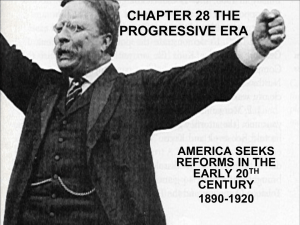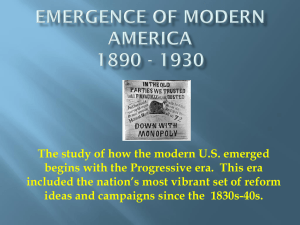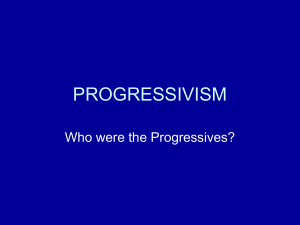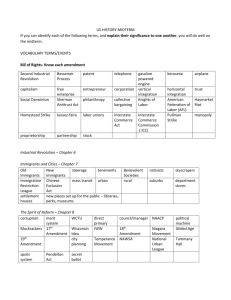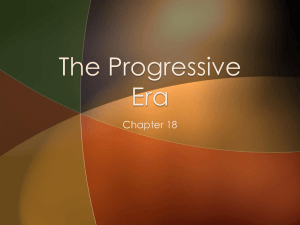Progressive Reform
advertisement
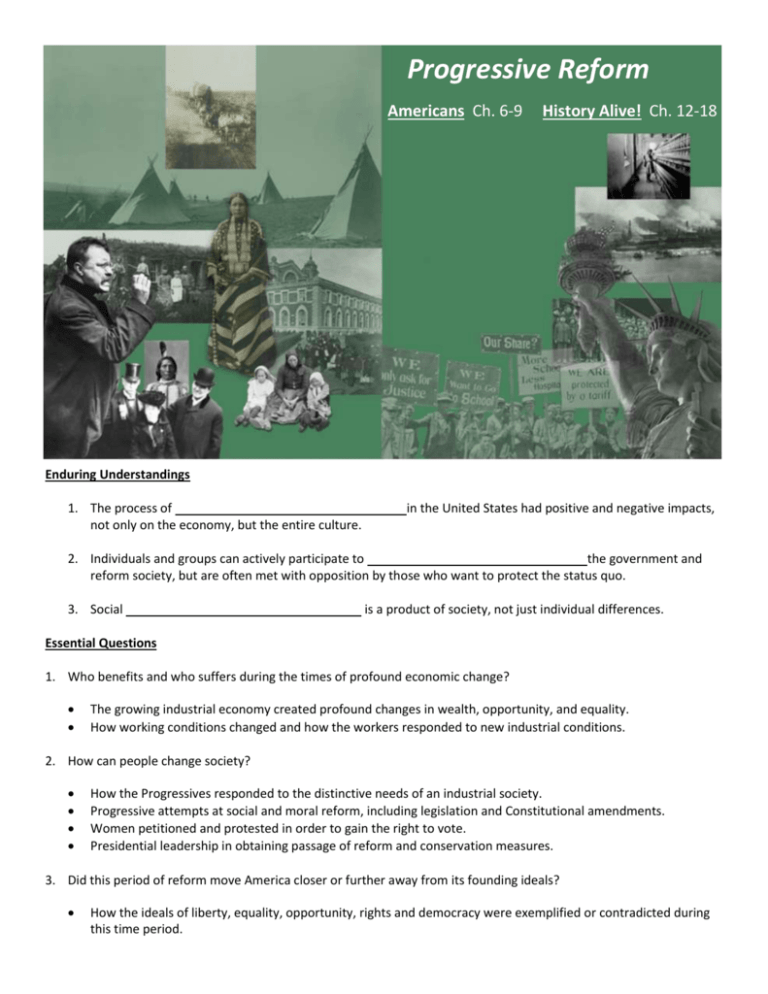
Progressive Reform Americans Ch. 6-9 History Alive! Ch. 12-18 Enduring Understandings 1. The process of not only on the economy, but the entire culture. in the United States had positive and negative impacts, 2. Individuals and groups can actively participate to the government and reform society, but are often met with opposition by those who want to protect the status quo. 3. Social is a product of society, not just individual differences. Essential Questions 1. Who benefits and who suffers during the times of profound economic change? The growing industrial economy created profound changes in wealth, opportunity, and equality. How working conditions changed and how the workers responded to new industrial conditions. 2. How can people change society? How the Progressives responded to the distinctive needs of an industrial society. Progressive attempts at social and moral reform, including legislation and Constitutional amendments. Women petitioned and protested in order to gain the right to vote. Presidential leadership in obtaining passage of reform and conservation measures. 3. Did this period of reform move America closer or further away from its founding ideals? How the ideals of liberty, equality, opportunity, rights and democracy were exemplified or contradicted during this time period. INDUSTRIALIZATION AND URBANIZATION In the decades following the C (1870 – 1910) War, industrialization moved America further and further away from Thomas Jefferson’s vision of a country populated by independent and self-sufficient industrial era was characterized by the development of the transcontinental . The , which served as a major catalyst for western expansion and national economic growth and fueled the rise of heavy and large . By the end of the 19th century, the United States had become a technologically society — an economic colossus that produced close to one- advanced and increasingly of the world’s goods. There was an explosion of discovery in the late 19th century with the invention of such technologies as the t ,e light bulb and p . Incredible new evolved so that inventions such as these could be produced for a mass market. Americans were proud of what these businesses accomplished and looked to industry and science as a to many of the world’s problems. These large and powerful corporations, headed by often philanthropic “c industry” such as Andrew C and John D. R of , dominated their competition. However, in the process of acquiring vast wealth, they exploited not only many of the nation’s natural , but also the thousands of European who worked for them. Environmental groups responded to threats to the natural environment and developed programs to try to America’s natural wonders. Movements also arose to address problems of p d faced by an over favored and under and urban workforce. The struggle between those who economic growth and those demanding better working conditions and a more livable environment would continue for generations to come. Time Line 1862 — The Federal H Act is passed. 1864 — President L sets aside the Yosemite Valley for preservation. 1865 — The Civil War ends. 1869 — The railroad is completed in Promontory, Utah. 1869-1870 — The Utah and Wyoming territories give women the right to 1871 — Y . National Park is created. 1873 — Thousands of businesses close during a major financial . 1876 — Alexander Graham Bell holds the first public demonstration of the telephone at the Centennial Exposition in P . 1879 — Thomas develops the first practical light bulb. 1885 — The Santa Fe Railroad to southern California is completed. 1892 — John Muir helps to establish the S Club. Progressive Movement (~1890s-WW I era) The Progressive Movement at the turn of the th century was a response to the major social problems left in the wake of the nation’s unbridled expansion and the massive influx of new . from Europe. Progressive-era reformers sought to gain citizen control over the nation’s monopolistic corporations and had some success in improving the conditions of America’s industrial workforce. and Activists such as Jane Addams and Ida Tarbell addressed issues of women’s and exposed corporate excesses. and child labor like Lincoln Steffens and Upton Sinclair attacked and squalid conditions in America’s , political industry. Other more processing . groups such as the Socialists and the Industrial Workers of the World emerged and had substantial political adherents, but they were often maligned and mistreated because their beliefs placed them outside of the of the nation. While Progressive crusaders did not actively address issues of , African-American leaders Ida B.Wells-Barnett, Booker T.Washington and W.E.B. DuBois advocated different approaches for dealing with lynching, racism and cultural future progress in the area of , setting the course for significant rights. Progressives found political .in Presidents Theodore Roosevelt and Woodrow Wilson. Although they had different political agendas, both helped ensure that such as the Pure Food and Drug Act, the Clayton Anti-Trust Act and the Federal Reserve Act were passed. While brought the Progressive Movement to a halt, the spirit of reform would reemerge strongly in the future. Time Line 18 —Clara Barton assists in founding the American Red Cross. 1881—Booker T. Washington founds the T Institute in Alabama. 1889—Jane Addams and Ellen Gates Star open 1890—The in Chicago. Anti-Trust Act is enacted. 1892—Almost two hundred African-Americans are in the United States. 1901—President McKinley is assassinated; Theodore Roosevelt becomes president. 1904—Ida Tarbell writes an expose of the Standard 1905—I W Trust Company. of the W 1906—Upton Sinclair publishes The is formed (a.k.a The . 1906—The federal Meat Inspection Act is passed. 1906—The 19 Food and Drug Act is enacted. —The NAACP is founded. 1909—The National Conservation Commission is formed. 1912—W W 1914—The Clayton Anti-Trust Act is passed. 19 —World War I begins in Europe. is elected president of the United States. ) Vocabulary —A monopolistic oil company, founded in the late 19th century by John D. Rockefeller, that controlled much of the production, refining and transport of oil in the United States. —An American reform movement within both major political parties, from about 1890 to World War I, that pressed for legislation to reform many aspects of America’s urban and industrial system. Hull House—The first social settlement house in America. Founded by Jane and Ellen Gates Star in Chicago in 1889, it served as a shelter and an educational center, especially for children of immigrants child labor reform—One of the political and social of Progressives which sought to regulate the age and the conditions of work for children. —The act of getting people of different ethnic cultures to change their ways by adopting American culture. Tammany Hall—First organized after the Revolution as a patriotic society in New York City, it later became a political club and then the Democratic political machine that controlled the of the city. —A term first used by President Theodore Roosevelt to describe writers and journalists such as Lincoln Steffens, Ida Tarbell, and Upton Sinclair, who exposed the problems of America’s industrial system. The Jungle—A shocking, best-selling 1906 book written by Upton Sinclair that addressed conditions in America’s meat processing plants. and The Pure Food and Drug Act—A 1906 law passed by the Roosevelt administration that created agencies to ensure that food and medicines produced by American corporations were . —During the Progressive Era, the term first used to describe a business monopoly. trust-busting—A term to describe legal and court actions that attempted to break up the trusts and to make monopolies . Clayton Anti-Trust Act—A law approved in 1914 that increased government regulation of business, attempting to limit monopolistic practices by America’s largest . Federal Reserve Act—A law passed by Congress in 1913 that created the Federal Reserve System, the United States central system that regulates the nation’s money supply. The Progressive Party—The political party founded by Theodore Roosevelt to enable him to run as a third party candidate in the election of 1912, also known as the Party. Plessy vs. Ferguson—A decision by the U.S. Supreme Court in through “separate but equal” facilities. that legalized the segregation of the races —A particularly brutal vigilante or mob killing of another person. Thousands of African Americans were killed in the South in the late 19th and early 20th centuries. From the roots of progressivism to settlement houses, muckrakers and city bosses, the United States had become a truly modern nation. The American people fought the trusts and enacted political reforms that heightened the differences between the New Nationalism and the New Freedom. This program also follows the Suffrage Movement and introduces progressive educators like Booker T. Washington and W.E.B. Du Bois, as well as political fads like the Socialists and Wobblies. History Alive! Chapter 13: Age of Innovation and Industry Innovations in technology and business boosted American industry in the late 1800s. Large steel, oil, and railroad corporations dominated the economy, with little governmental control. Industrial expansion produced greater access to goods and services, and it improved standards of living for many Americans, but not all. Innovations and inventions Innovations, such as the electric light bulb and kerosene, spurred the growth of new industries. The telegraph and telephone brought modern communications to homes and businesses. The Bessemer process lowered the cost of steel and encouraged new forms of construction. New business techniques Business leaders formed corporations to attract capital from investors, who became owners by buying stock. They improved production methods in order to mass-produce more goods in less time. By promoting horizontal or vertical integration, some leaders gained control of major industries. They also sought to reduce competition by forming monopolies and trusts. Laissez-faire The federal government generally adopted a laissez-faire policy toward business. This hands-off approach reflected a belief in social Darwinism. The Sherman Antitrust Act was only feebly enforced. The Gilded Age While industrialists amassed great fortunes, society was tainted by political corruption and a huge gap between rich and poor. Carnegie, Rockefeller, and Vanderbilt used some of their wealth to promote the common good. Historians debate their overall impact, noting increased industrial productivity but also unfair business practices. Ch. 14: Labor’s Response to Industrialism The efforts of industrial workers in the late 1800s helped boost the American economy. Yet factory owners often treated their workers poorly, imposing low wages, long hours, and poor working conditions. Many workers joined labor unions to fight for better treatment and to raise their standard of living. But hostility between unions and employers sometimes led to violence. Working-class conditions The working class suffered greatly during the Gilded Age. Industrial workers accepted low pay and dangerous conditions because they could not afford to lose their jobs. Many working-class families occupied rundown tenements in poor city slums. Child labor American industry relied on the labor of whole families, including children, who often worked longer hours than adults. Labor unions Workers united to form labor unions and to negotiate better wages and working conditions. Union membership increased with the rise of national unions and labor federations, such as the American Federation of Labor. Strikes Failed negotiations led often to strikes and sometimes to violence. The government generally took the side of business and industry and often helped to break strikes. Losses and gains for workers Periodic depressions shrank union membership, while violent incidents like the Haymarket Affair, Homestead Strike, and Pullman Strike helped turn public opinion against unions. However, unions gained wage increases and reductions in work hours. Ch. 15: Through Ellis Island and Angel Island In the late 1800s and early 1900s, large numbers of immigrants came to the United States. Most emigrated from Europe, but many also arrived from Asia and from other parts of North America. They all saw the United States as a land of opportunity, but they faced challenges entering the United States and assimilating into American culture. Push and pull factors Overcrowded cities, civil unrest, and shortages of food, land, and jobs pushed immigrants out of their homelands. The promise of wealth, jobs, land, and freedom pulled them to the United States. Through Ellis Island In the late 1800s, Europeans crossed the Atlantic on steamships, many of them in steerage. In New York Harbor, steerage passengers underwent a medical inspection and a legal interview at the Ellis Island Immigration Station. Most of these new immigrants found homes in the ethnic neighborhoods of large cities or on farms in the Midwest. Through Angel Island Asians immigrated to the United States in smaller numbers than Europeans. Chinese, Japanese, Koreans, and Filipinos found work mainly on the commercial farms of the West Coast. After 1910, Asians had to pass a rigorous inspection at the Angel Island Immigration Station before entering the country. Across the northern and southern borders Other immigrants came from Mexico and French Canada. Mexican immigrants tended to settle in the Southwest and California. Immigrants from French Canada settled mainly in New England and the Great Lakes states. Both ethnic groups faced many of the same challenges as immigrants from other countries. Nativism Some Americans objected to mass immigration, especially from Asia and southern and eastern Europe. Strong opposition from nativists led to the persecution of immigrants and restrictions on immigration. Ch. 16: Uncovering Problems at the Turn of the Century Americans faced social, political, and environmental problems at the turn of the century. Many of these problems were the result of rapid changes brought on by industrialization, urbanization, and immigration. Industrialization The rapid growth of industry resulted in poor working conditions for many workers. Monopolies took over industries, squeezing out competition. Some companies also made unsafe products. Muckraking journalists like Upton Sinclair, author of The Jungle, worked to expose these problems. Urbanization Cities grew rapidly with the rise of industry and increased immigration. The infrastructure in many cities could not meet the demands of a growing population. Many immigrants were crammed into poor ethnic neighborhoods, such as New York's Lower East Side, where they had few services. Environmental damage Industry and urbanization produced air and water pollution. Ranching, logging, and extractive industries also damaged the natural environment. Political corruption Political machines, like New York's Tammany Hall, fueled corruption in city government. Big businesses influenced state and national governments. Congress passed the Pendleton Act to clean up the federal government by creating a professional civil service. Tensions in society A growing gap between rich and poor fueled social tensions. African Americans suffered racism and mob violence, while women also faced discrimination. The temperance movement tried to limit or even ban alcohol consumption. Social changes strained American families, and many people feared the loss of traditional family bonds. Ch. 17: The Progressives Respond In the early 1900s, progressives worked to reform American society. Inspired by reform movements like populism and the Social Gospel, progressives tackled a variety of problems. They tried to improve living and working conditions in cities, clean up state and local government, and advance the rights of women and minorities. Urban living conditions Progressives like Jane Addams, the cofounder of Hull House, worked to fix up poor city neighborhoods. They tried to improve tenement housing, sanitation, and garbage collection. Worker protection Progressives fought to improve working conditions. They promoted laws limiting work hours and guaranteeing workers' compensation. They formed the National Child Labor Committee to campaign against child labor and get more children into school. Clean, responsive government Progressives sought to end government corruption at the local level. They worked to curb the power of political machines and restructure local government. They also worked to expand democracy at the state level. They supported reform governors like Robert La Follette and passed electoral reforms like the secret ballot, direct primary, recall, initiative, and referendum. Struggle for equal rights Women and African Americans sought to advance their rights. Reform goals included voting rights for women and an end to lynching and segregation. NAWSA led the struggle for women's suffrage, while the NAACP tried to secure equality for African Americans. Ch. 18: Progressivism on the National Stage Three progressive presidents—Theodore Roosevelt, William Howard Taft, and Woodrow Wilson—held office from 1901 to 1921, during the Progressive Era. Their goals and styles of leadership differed, but they all worked to bring about reforms on the national level. Three distinct leaders Despite their varying leadership styles, the progressive presidents believed in using government to improve society. In carrying out reform programs, such as Roosevelt's Square Deal and Wilson's New Freedom, they increased the power of the presidency. Addressing the effects of industrialization Reformers passed laws to break up monopolies and help workers. They tried to protect consumers through such laws as the Pure Food and Drug Act. They also tried to preserve the environment by conserving resources. Sixteenth Amendment This amendment established a federal income tax, which progressives favored as a means to fund government programs. Congress made the tax a graduated income tax, which placed a heavier tax burden on the wealthy. Seventeenth Amendment This amendment established the direct election of U.S. senators, another progressive goal. It replaced the election of senators by state legislatures. Federal Reserve System Congress set up the Federal Reserve to bring stability to the banking system and prevent financial panics. The Fed, which consists of 12 federal banks, lends money to private banks and sets policies that govern interest rates and the amount of money in circulation. Eighteenth Amendment This amendment established prohibition, or a ban on alcohol. Many progressives believed that alcohol consumption was a serious social ill. Nineteenth Amendment This amendment guaranteed women the right to vote. This was an important progressive goal designed to advance democratic rights.

